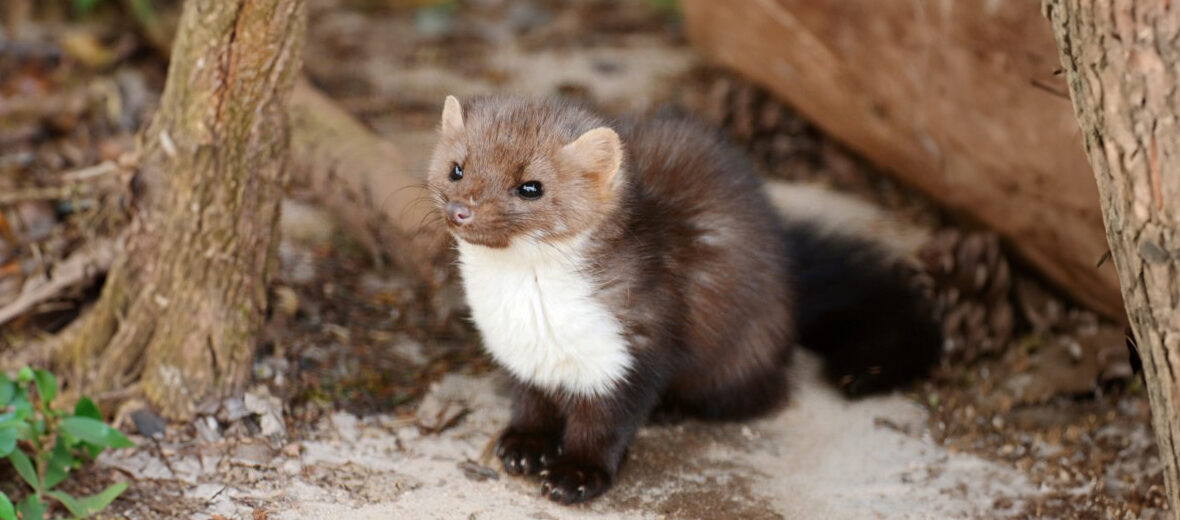
The beech marten, aka house marten, stone marten, or white breasted marten, dwells throughout Europe and south Asia, including the Middle East. A feral population also exists in Wisconsin, in the United States. These martens face the threats of habitat loss and destruction at the hands of farming and ranching; hunting; and trapping. However, they are abundant with a stable population throughout their ranges, and thus earn the listing of Least Concern by the IUCN.
First the Stats…
Scientific name: Martes foina
Weight: Up to 4.63 lbs.
Length: Up to 21.26 inches, plus up to a 11.81 inch tail
Lifespan: Up to 18 years
Now on to the Facts!
1.) They are relatively similar to the European pine marten, sans their smaller size and preference of habitat.
2.) The earliest fossil records were found in deposits dated to the Würm glaciation in Lebanon and Israel.
3.) Beech martens may have arrived in Europe by the Late Pleistocene or the early Holocene epoch.
4.) These critters have evolved a propensity towards hypercarnivory (diet that consists of 70% or more of meat).
5.) As they were faced with selective pressures, they de-evolved a wider gape in exchange for a more powerful bite force.
But wait, there’s more on the beech marten!
6.) By 2005, 11 subspecies of these martens were recognized.
7.) Beech martens are both crepuscular (active at dawn and dusk) and nocturnal (active at night).
Did you know…?
In urban locations, these martens will take up residence in buildings during the winter.
8.) While mostly terrestrial (spend their lives on the ground), they are quite capable climbers.
9.) These martens are also skilled swimmers.
10.) During heavy snowfall, these critters move through paths made by hares.
But wait, there’s still more on the beech marten!
11.) They favor inhabited or uninhabited stone structures, rock slide areas, and fissures to hide in, rather than dwelling in burrows.
12.) Mating takes place from June – July.
Did you know…?
Pioneering marine biologist Jeanne Villepreux-Power kept 2 tamed beech martens as pets.
13.) Copulation can take longer than 1 hour to complete.
14.) Females undergo up to a 237 day gestation (pregnancy) that yields up to 7 kits.
15.) Kits are weaned in up to 45 days.
But wait, there’s still a little more on the beech marten!
16.) Besides rats, mice, and various birds, fruits and vegetables are also eaten. Apples, black nightshade, cherries, grapes, mountain ash, pears, plums, raspberries, and tomatoes are regularly consumed. In lean times carrion (dead animals) is also eaten.
17.) On rare occasions the beech marten has been known to kill European polecats.
Did you know…?
Since circa 1970s, beech martens have been known to occasionally cause damage to vehicles. Cars attacked by martens usually have cut tubes and cables. It is not known as to why they behave in this manner.
18.) Red foxes, mountain lions, lynxes, golden eagles, and Eurasian eagle-owls typically prey on adults, and juveniles are susceptible to predation by birds of prey and wildcats.
19.) North American beech martens are most likely descended from feral animals that escaped a private fur farm in Burlington during the 1940s.
20.) On April 29th as well as November 21st 2016, 2 beech martens were able to shut down the Large Hadron Collider, the world’s most powerful particle accelerator, by climbing on 18 – 66 kV electrical transformers located above ground near the LHCb and ALICE experiments.
Now a Short Beech Marten Video!
This video talks about the differences between beech martens, pine martens, and polecats.
Be sure to share & comment below! Also, check out the Critter Science YouTube channel. Videos added regularly!
Want to suggest a critter for me to write about? Let me know here.
Some source material acquired from: Wikipedia & IUCN
Photo credit: BioLib




